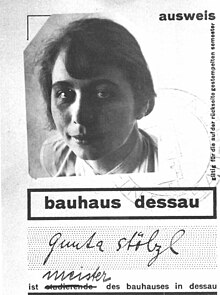Gunta Stölzl
| Gunta Stölzls | |
|---|---|
 |
|
| Born |
5 March 1897 Munich, German Empire |
| Died | 22 April 1983 (aged 86) Zurich, Switzerland |
| Nationality | Swiss |
| Known for | Weaving |
Gunta Stölzl (5 March 1897 – 22 April 1983) was a German textile artist who played a fundamental role in the development of the Bauhaus school’s weaving workshop. As the Bauhaus’ only female master she created enormous change within the weaving department as it transitioned from individual pictorial works to modern industrial designs. Her textile work is thought to typify the distinctive style of Bauhaus textiles. She joined the Bauhaus as a student in 1920, became a junior master in 1927 and a full master the next year. She was dismissed for political reasons in 1931, two years before the Bauhaus closed under pressure from the Nazis.
The textile department was a neglected part of the Bauhaus when Ms. Stölzl began her career, and its active masters were weak on the technical aspects of textile production. She soon became a mentor to other students and reopened the Bauhaus dye studios in 1921. After a brief departure, Stölzl became the school's weaving director in 1925 when it relocated from Weimar to Dessau and expanded the department to increase its weaving and dyeing facilities. She applied ideas from modern art to weaving, experimented with synthetic materials, and improved the department's technical instruction to include courses in mathematics. The Bauhaus weaving workshop became one of its most successful facilities under her direction.
Stölzl was born in Munich, Bavaria. She attended a high school for the daughters of professionals, graduating in 1913. She began her studies at the Kunstgewerbeschule (School of Applied Arts) in 1914, where she studied glass painting, decorative arts and ceramics under the well known director Richard Riemerschmid. In 1917 Stölzl's studies were interrupted by the ongoing war and she volunteered to work as a nurse for the Red Cross, behind the front lines until the end of World War I in 1918. Upon her return home she re-immersed herself in her studies at the Kunstgewerbeschule in Munich, where she participated in the school's curriculum reform. It was during this time that Stölzl encountered the Bauhaus manifesto. Having decided to continue her studies at the newly formed Bauhaus school, Stölzl spent the summer of 1919 in the glass workshop and mural painting classes of the Bauhaus to earn her trial acceptance into Johannes Itten’s preliminary course. By 1920, Stölzl had not only been fully accepted into the Bauhaus school, but had received a scholarship to attend.
...
Wikipedia
